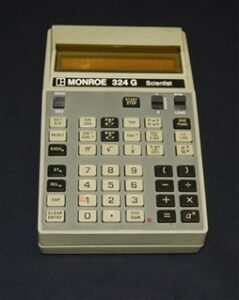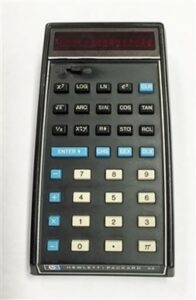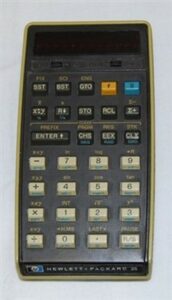
32. Finally, Computers could be taken to the Field
By Gordon Olsson
Even though desktop computers were available in most survey offices in the 1970s, surveyors still used Curta calculators. Curta calculators are discussed in Article 21 Too Cumbersome for the Field – Mechanical Calculators.
In the early 1970s, “handheld” or “pocket” calculators and computers were introduced. They were small and portable and could easily be carried to the field in a pocket of a surveyor’s vest. Curta calculators were soon relegated to posterity. As more functionality was added to the handhelds, such as programming, surveyors also used them in the office.
While the terms calculator and computer are occasionally used interchangeably, the term computer is generally used when the device is programmable.
The first handhelds performed only basic calculations such as addition, subtraction, multiplication and division. Soon trigonometric functions were added which saved carrying a book of functions. Many companies produced and marketed these early calculators: Texas Instruments, Sharp, Sears, Radio Shack and others. However, for land surveyors those produced by Hewlett- Packard eventually came to the forefront.
The first programmable handheld computers did not come with land survey software. However, they were easy to program. Surveyors developed their own programs for traverse closures, area calculations and curve intersections. Generally programming was by what was called Basic programming. For example, for the HP-25, programming involved sliding a PRGM-RUN switch to PRGM and then pressing a sequence of keys in the order that the calculation would be performed manually. When the switch was returned to run, the program was in the computer ready to be used.

Monroe 324G Scientist. The Computer Design Corporation of Los Angeles built desktop and portable computers in the early 1970s and marketed them under their own brand name “Compucorp” as well as other companies most notably “Monroe.” The company manufactured the Monroe 324G Scientist in 1973. It had trig functions and two independent 80-step programs. Although the 324G was relatively small it was a stretch to call it a handheld as it was 23 x 14 cm in size. Compucorp did not survive because of market pressures and the rapid change in the 1970s in computer technology.
Donated by Dave Williams, ALS (Ret.)
ALSA 2008.14.06

Hewlett Packard 35. The HP-35, Hewlett Packard’s first pocket calculator, was introduced in 1972. William Hewlett gave his engineers the goal to develop a computer that was small enough to fit into his shirt pocket (thus the name pocket calculator). It was called the 35 as it had 35 keys, including trig functions, a key that gave the log and one that gave the anti-log.
Donated by Lou Breton, ALS (Hon. Life)
ALSA 2008.04.01

Hewlett Packard 25. The HP-25 was introduced in 1975. It was called a calculator by Hewlett Packard, however, because it was programable it was by current definition a computer. It was ideal for surveyors at the time as it had built-in trigonometric functions and was programmable with 49 lines of memory. However, when the computer was turned off the program was lost and would have to be re-entered for subsequent computations. When the HP-25c was introduced one year later, as an upgrade to the HP-25, programs were able to be retained. The batteries in the HP-25 were rechargeable with an included charger.
Donated by Monroe Kinloch, ALS (Hon. Life)
ALSA 2008.02.05
Sources of Information:
- Vintage Calculators Web Museum: http://www.vintagecalculators.com/index.html
- Matt Lake, Article in Computerworld. May 18, 2012.
- The Museum of HP Calculators: https://www.hpmuseum.org
- Frank Bensene, The History of Compucorp, Updated: 2020: https://www.oldcalculatormuseum.com/d-compucorp.html
Author: Gordon Olsson, ALS (Hon. Life)
December 3, 2022
Copyright 2024 © Alberta Geomatics Historical Society
